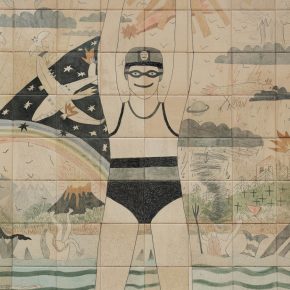Studio conversation with studio holder Andrew Gannon
This is… stuff that’s been accumulating over the past couple of years, since the pandemic, and I just finished an exhibition at Fruitmarket, it’s all boxed up and up there. They are objects, or they’re things that move between sculpture and performative objects. They’re made whilst wearing them, they’re all sort of disability objects.

I had to think how to center disability in my practice. Making work from a position of disability, not necessarily about disability, and to think about the job of a prosthesis and how it’s typically understood and what happens if we invert those intentions. If it isn’t functional in the way that we expect it to be functional, or if it isn’t cosmetic in the way we expect these things to be cosmetic, then what? What happens? I was making a lot of performance and performative action type work, so these things started as a way to wear something. Wearing as an action. What happens if the prosthesis is unusual? So, these were the beginning of a thought process if you like. And then they become about incorporating all the materials and thinking about what happens if I take my glass bottle recycling or something like that and put it in.
Looking at my previous projects, one of my objectives was to work with as little as possible and to use materials in a way that I could make the work and then put that material back into the world.
I made a series of works that involved borrowing. So I would see somebody in a coat, I would borrow that coat and put it on and I stand to have a photograph of me taken in the coat. I would be contorted into somebody else’s coat, photograph it, and then I would hand the coat back. That idea about taking and then giving back started me thinking about invisibility.
When I started thinking about this more recent work, about that need to center my disability in my practice, suddenly that became about making it visible. So, it switched; it inverted. The objects that I started making became more and more sculptural. Predominantly, the material has been plaster of Paris. It’s like a bandage, one foot in the art world and one foot in the medical world. It’s a material that occupies both. It will hold a shape and hold other objects. It’s also incredibly quick to work with, I wanted things to be done quickly to make these casts on myself, and this material really works in that respect.
I quite like how the performative element is still present even when the works are more overtly sculptural, like the ones I was making for the Fruitmarket exhibition.
I started binding the cast to itself, to other casts, so, again this idea of working with materials that were to hand. Binding these things together it became apparent that these limb casts that I was making are an everyday object, just not familiar to everybody. For somebody who’s had prostheses made all my life, I’ve grown up with them, and every prosthetist I speak to, or anybody else who wears a prosthesis, immediately knows what these plaster objects are, although they’re quite unusual to other people.
Some of the sculptures are painted. I think they do a completely different thing when they’re white. They speak of how they’ve been made and the material that they’re made out. Painting them just changed their visibility completely. But, again, it’s the idea of prosthesis or disability objects, and how we expect them socially to disappear into the background. We don’t want to see them. We want them to be invisible, or, if we do see them, we want to see them in very specific context.
I’ve just finished that exhibition which ended up swinging in a really sculptural, formal direction, even though there were performative works in it. Something about insisting that disability was allowed to fully occupy the gallery space, a space it’s not normally seen in, meant we used gallery furniture in a very formal way. But, I’m interested in thinking about how they can sit formally in different places without having to change, without interfering with the integrity of the object.
From as long ago as I can remember I have heard: how did you lose your arm? Well, I never lost my arm, I was born different. There’s just this social assumption that there is an absence that needs filling. And there’s a responsibility or need to fill it. People project onto me that something should go there.
What happens if you mess with those norms? What happens if you take those expectations and invert them more deliberately, confront them more or take them in the other direction? I’m thinking about how these objects, that were effectively cast of myself, bound together… what happens if I take those as proposals for works that could involve multiple people with limb differences? What happens if we take this space, and we explode it and we make it really big and we occupy it in ways that shouldn’t be.
I started 20 odd years ago. My undergrad was in painting, and I was making drawings and paintings then I moved towards a more of conceptual or performance led way of thinking. And now I am moving to sculpture.

Studio conversation with studio holder Andrew Gannon, March 2023
More about Andrew’s work here




